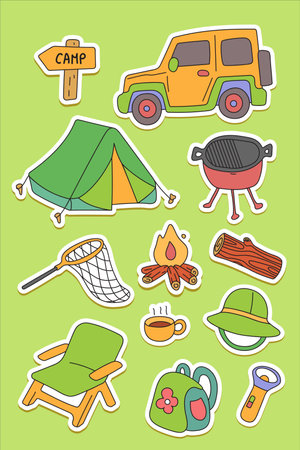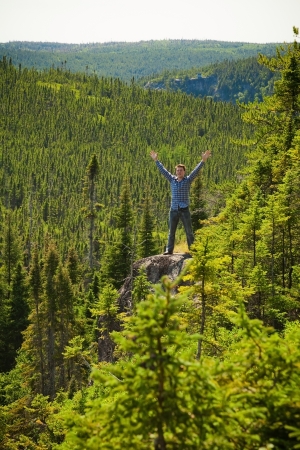1. Choosing the Ideal Campsite
Picking the right spot to set up camp is one of the most important parts of backcountry camping. It’s not just about finding a flat piece of ground—you’ll need to think about safety, comfort, and following the rules that keep wild places beautiful for everyone.
Key Factors When Selecting Your Campsite
| Factor | What to Look For | Why It Matters |
|---|---|---|
| Terrain | Flat, level ground free from rocks, roots, and sharp objects; avoid low spots where water collects | Avoids uncomfortable sleep and risk of flooding during rain |
| Proximity to Water | At least 200 feet away from lakes, rivers, or streams | Protects water sources from contamination and wildlife traffic |
| Wind and Weather Protection | Sheltered by trees or natural features, but not under dead branches (“widowmakers”) | Keeps you safer from falling limbs and harsh weather |
| Legal Restrictions | Check park or forest rules; use designated sites when available; respect posted signs | Reduces impact on the environment and avoids fines or citations |
| Leave No Trace Principles | Use existing campsites if possible; camp on durable surfaces like gravel or dry grass; avoid fragile vegetation | Keeps nature wild for future campers and minimizes your footprint |
Scout Like a Pro: What to Avoid
- Avoid animal trails and berry patches: These are popular wildlife hangouts.
- Avoid pitching your tent in gullies or dry creek beds: Flash floods can happen fast.
- Avoid ridge tops or open meadows in stormy weather: You’re more exposed to lightning and wind.
- Avoid areas with lots of bugs: Swampy spots or standing water attract mosquitoes—no one wants that!
The “200 Feet Rule” Explained
The general guideline in the U.S. is to camp at least 200 feet (about 70 big steps) away from any water source, trail, or other campsites. This gives wildlife space to access water and keeps the area looking pristine for others.
Quick Checklist for Camp Selection
- Flat ground, clear of debris?
- Away from hazards (dead trees, flooding risks)?
- Not too close to water (at least 200 feet)?
- No signs of recent wildlife activity?
- Following local rules and Leave No Trace guidelines?
2. Shelter Setup and Sleeping Arrangements
Choosing the Right Spot for Your Tent
Picking the perfect location is key to a good night’s sleep in the backcountry. Look for a flat, level area that’s free of rocks, roots, and debris. Avoid low spots where water can pool if it rains. If you’re camping in bear country, set up your tent at least 200 feet away from where you cook or store food. Try to find natural windbreaks like trees or boulders, but make sure you’re not under dead branches that could fall.
Level Ground vs. Sloped Ground
| Type of Ground | Pros | Cons |
|---|---|---|
| Level Ground | Comfortable sleeping Less risk of rolling off pad Better rain runoff control |
Can be harder to find in hilly terrain |
| Sloped Ground | Easier to spot quickly May offer better views |
You may slide during sleep Uneven weight distribution on tent poles |
Pitching Your Tent Like a Pro
- Lay out your footprint: Always use a ground cloth or footprint to protect your tent floor from moisture and abrasion.
- Stake corners first: Secure the four corners tightly to keep your tent stable.
- Add guylines: Use all provided guyout points to help your tent stand up to wind and rain.
- Tighten the rainfly: Make sure your rainfly is taut so water rolls off instead of pooling on top.
Staying Protected from Wind and Weather
If wind is an issue, position the lowest side of your tent toward the prevailing wind direction. Use extra stakes or rocks to anchor your shelter. In wet conditions, check that your tent seams are sealed and avoid touching the inside walls, which can cause leaks.
Shelter Setup Checklist
| Shelter Task | Why It Matters |
|---|---|
| Choose flat ground | Avoids discomfort and water pooling under tent |
| CLEAR debris before pitching tent | Protects tent fabric and prevents punctures |
| Stake down every corner and guyline | Keeps tent secure in wind or storms |
| Use a rainfly even if it’s clear out | Dew and surprise showers are common in the backcountry |
| Aim entrances away from wind direction | Makes entering/exiting easier and keeps rain out |
Sleeping Arrangements for Maximum Comfort
- Select a quality sleeping pad: It insulates you from the cold ground and adds comfort.
- Pillow alternatives: Use a stuff sack filled with clothes if you don’t have a camp pillow.
- Bedding layers: Adjust sleeping bag warmth based on expected nighttime temps; add liners for chilly nights.
Pro Tip: Store electronics and clothing inside your sleeping bag overnight to keep them warm and dry!
- Select a quality sleeping pad: It insulates you from the cold ground and adds comfort.
- Pillow alternatives: Use a stuff sack filled with clothes if you don’t have a camp pillow.
- Bedding layers: Adjust sleeping bag warmth based on expected nighttime temps; add liners for chilly nights.
Pro Tip: Store electronics and clothing inside your sleeping bag overnight to keep them warm and dry!

3. Camp Kitchen and Food Storage
Setting Up a Functional Camp Kitchen
A well-organized camp kitchen makes cooking in the wild much easier and keeps your campsite safe. Choose a flat spot at least 200 feet away from your tent, water sources, and trails. Use a sturdy table or a clean tarp as your prep area. Keep all cooking gear—like stoves, utensils, pots, and pans—in one designated spot for easy access.
Recommended Camp Kitchen Setup
| Item | Purpose |
|---|---|
| Portable stove & fuel | For reliable cooking |
| Lightweight cookware | Pots, pans, utensils for meal prep |
| Cutting board & knife | Food prep |
| Sponge & biodegradable soap | Cleaning up after meals |
| Bear-proof food container or hang bag kit | Safe food storage |
| Ziploc bags or containers | Keeping leftovers sealed |
| Trash bags | Packing out waste |
Safe Food Handling in the Backcountry
Keeping food safe starts with cleanliness. Always wash your hands before handling food and use separate utensils for raw and cooked foods to avoid cross-contamination. If you’re bringing perishable items like meat or dairy, pack them in a cooler with plenty of ice packs and use them early in your trip. Stick to shelf-stable items like dehydrated meals, nuts, and energy bars for longer adventures.
Tips for Safe Food Handling:
- Wash hands thoroughly with soap and water (or hand sanitizer) before preparing food.
- Avoid leaving food out; store it immediately after meals.
- If you drop food on the ground, do not eat it—wildlife may be attracted to scraps.
- Purge trash regularly and keep it sealed until you can pack it out.
Wildlife-Proof Food Storage Methods
One of the most important parts of backcountry camping is preventing wildlife encounters by storing food properly. In many areas of the U.S., especially national parks, bears and other animals are common visitors near campsites. Here’s how to keep your camp safe:
Bears and Critters: Do’s & Don’ts Table
| Do’s | Don’ts |
|---|---|
| Use bear canisters or approved bear bags for all food and scented items. | Never store food in your tent or sleeping area. |
| Hang food bags at least 10-12 feet off the ground and 6 feet from tree trunks if bear poles/cables are available. | Avoid leaving empty wrappers or scraps around camp. |
| Store toiletries (toothpaste, sunscreen) with your food. | Don’t assume small animals won’t get into unsecured food—mice, raccoons, and squirrels will try! |
| Cook and eat meals at least 200 feet from where you sleep. | Avoid using heavily scented foods like canned fish near camp if bears are known to be active. |
By organizing your camp kitchen and storing food correctly, you’ll enjoy tasty meals without attracting unwanted wildlife visitors—making your backcountry stay safer and more comfortable!
4. Campfire Safety and Lighting
Building a campfire is a classic part of the American camping experience, but it comes with responsibility. Knowing how to safely create and manage a fire is key for warmth, cooking, and lighting while protecting the wilderness around you.
Check Regulations Before You Strike a Match
Before setting up a fire, always check local regulations. Many U.S. national parks, state parks, and forests have rules—sometimes seasonal bans—about open flames due to wildfire risk. Look for posted signs or ask a ranger. Some areas require you to use established fire rings or prohibit fires entirely. Failing to follow these rules can lead to fines or even cause accidental wildfires.
Common Campfire Restrictions Table
| Location Type | Open Fires Allowed? | Alternatives Required? |
|---|---|---|
| National Parks | Varies (check locally) | Portable stoves recommended |
| State Parks | Usually in designated rings only | Stoves if fire ban active |
| Backcountry/BLM Land | Often restricted during dry months | Sterno, gas stoves, lanterns |
| Private Campgrounds | Generally allowed in pits/rings | N/A unless otherwise posted |
Safe Fire-Building Techniques
If fires are permitted, follow Leave No Trace principles:
- Use existing fire rings instead of making new ones.
- Clear away dry leaves, sticks, and flammable material from the area.
- Keep your fire small—just big enough for your needs.
- Never leave your fire unattended.
- Always have water and a shovel nearby to extinguish the flames quickly if needed.
- Drown the fire completely before you leave; stir the ashes until they’re cold to the touch.
Step-by-Step: Building a Safe Campfire
- Gather tinder (dry grass, small twigs), kindling (sticks), and fuel wood (logs).
- Create a base of tinder in the center of the ring.
- Add kindling in a teepee or log cabin shape over the tinder.
- Light the tinder with matches or a lighter; add more kindling as it catches.
- Add fuel wood gradually as the fire grows stronger.
- Maintain control—don’t overload the fire with too much wood at once.
Campsite Lighting Alternatives
If fires aren’t allowed or you want something easier, there are safe alternatives for light and cooking:
- LED Lanterns: Battery-powered lanterns give bright light without any risk of sparks or embers.
- Headlamps: Perfect for hands-free light around camp or inside your tent.
- Camp Stoves: Propane or liquid fuel stoves are efficient for cooking and are usually allowed even when open fires are not.
- Chemical Heat Packs: Great for extra warmth inside sleeping bags on chilly nights.
Campsite Lighting Options Comparison Table
| Lighting Option | Main Use | Pros | Cons |
|---|---|---|---|
| Candle Lanterns | Mood lighting/warm glow | No batteries needed, portable | Poor in wind, potential fire hazard |
| LED Lanterns/Headlamps | Main campsite/tent light | No flame risk, long battery life, lightweight | Batteries required, less ambiance than firelight |
| Chemical Glow Sticks | Kid-friendly emergency light | No flame/battery needed, waterproof | Lacks brightness, single-use only |
| Campfire (if allowed) | Total camp experience: warmth/cooking/light/atmosphere | Cultural tradition, multi-purpose use | Spark risk, legal restrictions, cleanup required |
Your safety—and that of America’s beautiful wild places—depends on smart choices when it comes to campfires and lighting. Always respect local rules and use safe techniques so everyone can enjoy the outdoors for generations to come.
5. Waste Management and Leave No Trace
Why Proper Waste Management Matters
Keeping your campsite clean isn’t just about comfort—it’s about protecting nature for everyone. In the American backcountry, respecting the environment means managing your waste responsibly and following Leave No Trace (LNT) principles. This ensures that wild places stay beautiful and safe for future adventurers.
Backcountry Sanitation Essentials
When you’re far from restrooms, it’s important to handle human waste properly. Here’s a quick guide:
| Method | How To Do It | What You Need |
|---|---|---|
| Cat Hole | Dig a hole 6-8 inches deep at least 200 feet from water, trails, and camp. Cover with soil after use. | Trowel, toilet paper (pack out or bury), hand sanitizer |
| WAG Bag/Portable Toilet | Use provided bags or containers to collect waste and pack it out. | WAG bag/portable toilet kit, sealable trash bag for packing out |
| Toilet Paper Disposal | Packing out used toilet paper is best. If you must bury, do so deeply in the cat hole. | Ziploc bag or special “poop tube” for packing out TP |
Pro Tip:
Don’t forget to wash your hands or use sanitizer after handling waste. Clean hands keep you healthy on the trail!
Packing Out Trash: Everything Goes Home With You
No matter how small, every piece of trash should leave with you. This includes food wrappers, micro-trash (like twist ties), and even biodegradable items like orange peels—they don’t break down quickly in the wilderness.
| Trash Item | Packing Out Tips |
|---|---|
| Food scraps & wrappers | Store in a zip-top bag to control odor and leaks. |
| Cans & bottles | Rinse if possible and double-bag to avoid messes. |
| Cigarette butts & gum | Carry a small container just for these items. |
| Used hygiene products (wipes, pads) | Packed in a dedicated, sealable bag. |
The Seven Leave No Trace Principles
The Leave No Trace Center for Outdoor Ethics encourages everyone to follow these simple guidelines:
- Plan ahead and prepare.
- Travel and camp on durable surfaces.
- Dispose of waste properly.
- Leave what you find.
- Minimize campfire impacts.
- Respect wildlife.
- Be considerate of other visitors.
LNT in Action: Quick Checklist Before You Leave Camp
- No visible trash or food scraps?
- Campsite looks natural—like no one was there?
- No soap or waste in water sources?
- Packed out everything, including pet waste?
Treating our public lands with care ensures that America’s wild places remain wild for generations to come. Adopting good habits now makes backcountry living safer, cleaner, and more enjoyable for everyone!


